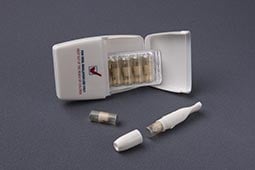How to Use the Nicotine Oral Inhaler
There are seven medicines approved by the Food and Drug Administration (FDA) to help you quit. They work in different ways. All have been shown to be safe and effective for adults who smoke cigarettes.
These quit-smoking medicines include nicotine replacement medicines (the nicotine patch, lozenge, gum, oral inhaler, and nasal spray) and pill medicines (varenicline and bupropion SR).
Some other strategies, with or without medicines, can help you quit as well.

The nicotine oral inhaler is a small plastic tube shaped like a fat cigarette. You need a prescription for it. You puff frequently on it with shallow puffs throughout the day. Unlike an asthma inhaler, the medicine is not inhaled into the lungs. The nicotine is absorbed mostly in the back of your throat. Your doctor or pharmacist can give you detailed instructions on how to use it. They can also help you set and adjust your dose.
- You’ll need a prescription from a prescribing healthcare provider for the nicotine oral inhaler.
- The nicotine oral inhaler may look similar to a cigarette, but you need to use it differently. You do not need to inhale as deeply for the medicine to work. Do not inhale into the lungs like a cigarette, and do not use it like a traditional asthma inhaler. Instead, take frequent, short, and shallow puffs from the inhaler, similar to how you might sip from a straw. Use the inhaler for four 5-minute sessions, or continually for about 20 minutes (which is about how long one cartridge will last).
- Use the nicotine oral inhaler often enough, as directed by your doctor or other healthcare provider, to help control cravings for cigarettes. To ensure that your body gets enough nicotine to ease your withdrawal symptoms, use at least 6 cartridges per day for the first 3 to 6 weeks. Do not consume more than 16 cartridges each day. Your doctor can help you set and adjust your dose and can talk about gradually reducing your dose when you are ready.
- Do not eat or drink for 15 minutes before using the inhaler, or during use.
- Keep out of reach of children and pets. Nicotine oral inhaler cartridges may have enough nicotine to make children and pets sick. When you are done using the inhaler, be sure to leave it in the locked position and store it out of reach of children and pets. When the cartridge is empty, immediately throw it in a secured trashcan that cannot be accessed by children and/or pets. In case of accidental use or ingestion, contact a Poison Control Center right away (1-800-222-1222).
- Quitting smoking may make some people depressed or anxious, whether quitting with medication or not. Get help if you have feelings of depression or anxiety that last for more than two weeks or that get worse.
- Learn more about the nicotine oral inhaler, including side effects and precautions.

- Consider combining the nicotine oral inhaler with nicotine patches if you continue to have withdrawal symptoms. Patches can provide a steady level of nicotine in the body to help lessen withdrawal, while the inhaler can be used to more quickly relieve cravings as they occur. You may need to use the inhaler less often if you are also using a patch.
- If you have strong cravings while using the nicotine oral inhaler, make sure you are using it often enough. If you smoke regularly, it’s best to use at least 6 cartridges a day for the first 3 to 6 weeks, and you can use up to 16 cartridges per day. You can also consider adding the nicotine patch, as discussed above.
- What if I slip up and smoke while using the nicotine oral inhaler? You do not need to stop using the nicotine oral inhaler if you slip up and smoke. Throw away your cigarettes and get back on track with your quit attempt. Keep using the nicotine inhaler as directed.
- How is the nicotine oral inhaler different than an e-cigarette? While the nicotine inhaler might seem a bit like an e-cigarette, there are some important differences. The nicotine inhaler has been an FDA-approved quit-smoking medicine for more than 20 years. The nicotine oral inhaler is regulated, and science has shown it is both safe and effective. Also, nicotine inhaled through the nicotine oral inhaler is not intended to be inhaled into the lungs—it is designed to be delivered into the mouth and throat area where it is absorbed. In contrast, e-cigarettes are tobacco products that are not FDA-approved as quit-smoking medicines and the long-term health effects of e-cigarette use are unknown. Learn more about e-cigarettes.
- For best results, use the nicotine oral inhaler as part of a program that includes coaching support. Talk with your healthcare provider and connect with your state tobacco quitline (1-800-QUIT-NOW) for help.
- Can be used regularly and when you feel withdrawal symptoms or urges coming on.
- Acts faster than nicotine patch or quit-smoking pills.
- Can be used with the patch to deal with breakthrough urges.
- You control how often you use it, so you won’t get more nicotine than you want.
- May help substitute for a cigarette because you put it in your mouth.
- You have to remember to use it regularly and often.
- Doesn’t work as well in cold weather.
- You should not eat or drink for 15 minutes before using or during use.
- May be visible to people around you when using.
- Requires a prescription.
Possible Side Effects (and what you can do about them):
- Mouth and throat irritation (very common, but may lessen with continued use).
- Runny nose, cough (often people get used to these. Talk to your doctor if they continue to bother you).
- Headache (Consider waiting longer between doses and talk to your doctor).
- Hiccups or stomach discomfort (try lower dose or wait longer between doses).
Oral Inhaler Precautions (If any of these apply to you, talk to your doctor or other healthcare provider before starting to use inhaler.):
- A heart attack in the last two weeks.
- A serious heart rhythm problem.
- Pain in your heart (angina) that is serious or getting worse.
- Asthma and chronic lung disease.
- Could be pregnant or are breastfeeding.
- Less than 18 years old.
More precautions and general information are available about oral inhaler.